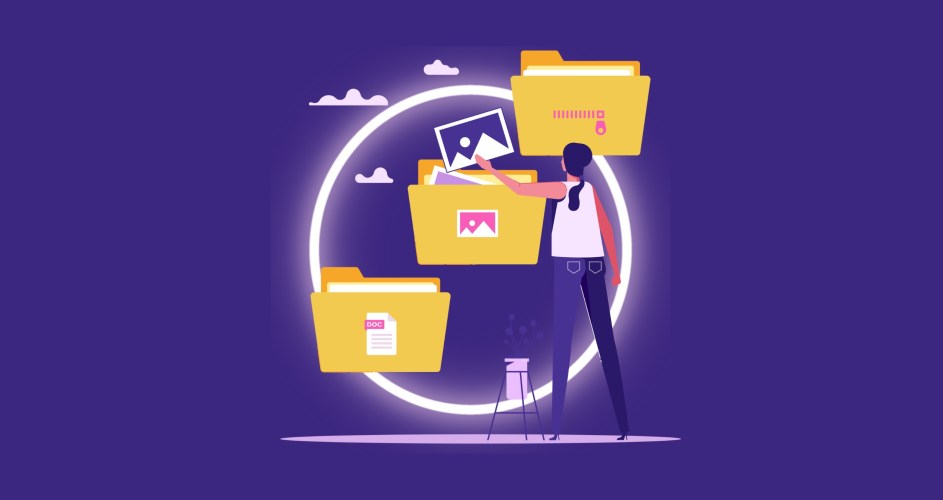Monday you’re designing social posts, Tuesday you’re formatting invoices, and Wednesday you’re up to your ears in customer inquiries. By Friday, you’re just exhausted. Does this sound familiar? This non-stop cycle forces you to recreate the same documents repeatedly. Templates can be your secret weapon in the day-to-day hustle. They give you a simple way to save time by cutting out repetitive work.
We get it, running a small or medium-sized business (SMB) means bouncing between urgent tasks with limited resources and even less time. Templates can help you cut your workload in half and make your business look twice as professional. That’s not a fantasy — that’s what happens when you use the right templates in your day-to-day operations. And how they can simplify your tasks and boost your business. Let’s dig in.
What we’ll cover:
- What are business templates and why use them?
- 10 free templates every small business owner needs
- Pro tips for getting the most from your templates
- Common mistakes to avoid when using templates
- How AI and CRM help you go beyond templates
- Simplify your business with the right templates
What are business templates and why use them?
Business templates are pre-designed documents, spreadsheets, or digital assets that provide a framework for common business activities. They’re the starting point that eliminates the need to create materials from scratch each time.
Templates aren’t just document shortcuts, they’re powerful business tools disguised as simple files. They’ll help you send professional invoices that get paid faster, create marketing emails with higher open rates, and build proposals that consistently win clients. The result? A smoother workflow and a business that consistently puts its best foot forward.
Templates make the biggest impact in areas requiring frequent communication or documentation – client onboarding, proposals, social media, invoicing, and project management are perfect examples where templates shine.
For busy SMB owners, templates offer three major benefits:
- Time savings: Creating documents from scratch consumes valuable hours. Templates let you jump straight to the content that matters.
- Brand consistency: Templatizing ensures your business communication maintains a professional, cohesive look across all channels.
- Reduced errors: With this structure in place, you’re less likely to forget important elements in routine documents.
Start with SMB Basics
Top 10 templates every small business owner needs to have
You’ve established your business, and things are moving along. Now it’s time to get organized and professional. These templates aren’t just nice-to-haves — they’re essential tools that will make running your business significantly easier. Each one solves a real problem small business owners deal with every day and they’re ready to use straight away.
1. Marketing planning templates
What it is: Documents that organize all your marketing activities in one place so you can schedule, track, and measure your marketing efforts.
From social media marketing to affiliate outreach — whatever your business needs to get out there, it should be templatized. Including templates for planning your social media posts, scheduling your email newsletters, and tracking how well each campaign performs. To make it even more valuable, consider adding areas for content ideas as they come to you and creating custom posting schedules that match when your audience is most active.
Where to get it: Salesforce provides various marketing templates for creating different types of campaigns and emails. These templates can be used for both web and email marketing. For web campaigns, templates provide a framework for personalization, allowing you to customize elements like promotional assets and product recommendations. For email marketing, templates can be created in Content Builder or by using HTML.
More resources from Trailhead, Salesforce’s free online learning platform:
- Agentforce Marketing Engagement For Industries
- Types of Classic Email Templates
- Email Creation and Sending
What can you do with a CRM built to reach more prospects?
Automate your marketing campaigns with a CRM built to grow. It all starts with Starter Suite.

2. Buyer persona creation templates
What it is: A profile outline that helps you define exactly who your ideal customer is so you can create more targeted marketing and a personalized customer experience.
Most buyer persona templates provide areas for customer demographics, their interests, challenges they face, and goals they want to achieve. Enhance your understanding by adding sections about which communication channels your customers prefer, past purchasing history, and what typically encourages them to make a purchase. A comprehensive template for your ideal customer profile should include:
- Name and photo: Create a fictitious name and a stock photo to make your persona feel real.
- Demographic information: Age, gender, income level, education, occupation, and location
- Family status: Marital status, number of children, household dynamics
- Goals and challenges: What do they aim to achieve and what obstacles do they face in their personal or professional life?
- Pain points: What specific problems or frustrations could your product or service solve for them?
- Buying behavior: How do they research options, what factors influence decisions, and what is their typical purchase journey?
- Communication preferences: What are their referred channels and methods for receiving information?
Where to get it: A customer relationship management (CRM) tool is a great place to build customer personas. It’s located right within the contact record, so you can use real customer data to make them more accurate. You can also start simple by jotting down what you already know about your audience.
Seeing is believing. Try Salesforce for free with a 30 day trial.
See how small businesses are using Salesforce CRM to scale fast. No credit card required, no software to install. It all starts with Starter Suite.

Thank you!
Try for free3. Target market segmentation templates
What it is: A tool for dividing your broader audience into specific groups with similar characteristics so you can customize your marketing approach for each segment.
Look for formats that let you organize customer information by demographics, interests, and behaviors. You can segment by adding fields for geographic location and specific buying habits that matter to your business. A complete template should include:
- Segmentation criteria: Who are they? Note basics like age, gender, income, education, job, location, and family status.
- Psychographic factors: What do they care about? Capture their lifestyle, values, personality, hobbies, and attitudes.
- Behavioral factors: How do they shop? Track how often they buy, their loyalty level, whether they’re new or regular customers, how much they use your products, and what benefits they’re seeking.
- Segment profiles: Give each group a name. Note how big the segment is, summarize their key traits, list their main problems, and how they prefer to be contacted.
- Market analysis: Is this segment worth pursuing? Assess growth potential, profitability, competition, and what resources you’ll need to target them effectively.
Where to get it: Salesforce offers templates that work with your marketing data to spot patterns and suggest new customer groups. If you’re just getting started, Google Docs has simple templates you can customize. Both can help you see how your customer segments fit together.
More resources:
4. Quote and estimate templates
What it is: A document that outlines potential costs for clients before they commit to purchasing your services or products.
A quote template includes organized areas for breaking down products or services, pricing details, and timeline estimates. Make yours more effective by adding terms and conditions sections and a place for client signatures to approve the work. A good template needs these elements:
- Header: Company logo, name, and contact information
- Client information: Client name, address, and contact details
- Quote/estimate number: Give the document a unique identifier
- Date: When the quote or estimate was created
- Project description: A brief overview of the project or service
- Itemized list: Breakdown of products or services, including quantities and prices, and any promotions or special rates applied
- Subtotal: Total cost before taxes and discounts
- Taxes and fees: Any applicable taxes, fees, or additional charges
- Total amount: Final amount the client will pay and any conditions for payment, including due dates and accepted methods
- Signature line: Leave a space for the client and company representative to sign
Where to get it: Salesforce provides templates that help you send quotes, collect approvals, and keep everything connected to your customer info. You can also download industry-specific templates from online quote generators.
More resources:
- Quote Templates in Salesforce CPQ
- Set Up Quote Templates
- Create Quote Template Guide – Trailhead – Salesforce
5. Invoice templates
What it is: A professional billing document that helps you request payment from clients in a clear, consistent format.
Every good invoice template contains areas for your business information, client details, invoice number, itemized services, pricing, totals, and payment terms. Personalize yours by adding sections for notes to the client, specific payment instructions, or early payment discounts. Pro tip: look for templates with electronic signature capabilities that allow clients to approve and pay invoices with just a few clicks.
Where to get it: Salesforce offers templates that help you create invoices quickly by pulling in client details from your records. Canva also has free templates you can customize, including automatic calculations.
More resources:
- How to Write an Invoice For Small Business (+ Free Template)
- Generate and Deliver Invoice Documents in Revenue Cloud
- A Complete Guide to Invoice Software for Small Businesses
6. Customer feedback survey templates
What it is: A simple way to collect insights directly from your customers about their experience with your products or services, giving you actionable information to make improvements.
Good customer feedback templates include questions about overall satisfaction, product quality, customer service experiences, and likelihood to recommend your business to others. Make yours even more valuable by adding open-ended questions that invite detailed responses and specific sections tailored to recent purchases or interactions.
Here are some example questions to start your feedback template:
- How would you rate your overall satisfaction with our product/service?
- What did you like most about your experience with us?
- Did you find our customer support helpful and responsive?
- Were our prices fair and competitive?
- How easy was it to navigate our website or store?
- Did our product/service meet your expectations?
- How likely are you to recommend our product/service to others?
- Do you have any additional comments or suggestions for us?
Where to get it: Salesforce offers customer feedback templates that connect responses directly to your customer records, making it easy to follow up on concerns or identify your biggest fans. SurveyMonkey and Google Forms provide free basic templates that work well when you’re just getting started. For something more integrated with your business processes, Starter Suite includes feedback tools that automatically update customer profiles based on survey responses.
More resources:
- Set Up a Customer Feedback Survey
- Customize the Survey Invitation Email Templates
- Create a Standard Survey
Wherever you are — just get started.
No matter where you are on your journey as a business owner, you can get started with Starter Suite for free — the CRM made for growth.

7. Email and communication templates
What it is: Pre-written message formats for common client interactions that save time and maintain consistent communication quality.
Email and communication templates include messaging for initial outreach emails to prospects, follow-ups, appointment confirmations, and post-purchase confirmation messages and thank you notes. Take your template to the next level by adding personalization fields and sections requesting specific feedback from clients.
Here’s a short list of communication templates you need:
- Welcome email: Introduces new customers to your business and provides initial information or offers.
- Invoice email: Sends invoices to clients with payment instructions and due dates.
- Follow-up email: Follows up on sales inquiries or customer interactions to maintain engagement.
- Thank you email: Expresses gratitude after a purchase or interaction.
- Newsletter email: Keeps customers informed about new products, services, and company news.
- Customer feedback request email: Asks customers for feedback to improve your business.
- Appointment confirmation email: Confirms scheduled appointments or meetings.
- Order confirmation email: Confirms orders and provides tracking information.
- Password reset email: Helps customers reset their passwords securely.
- Event invitation email: Invites customers to special events, webinars, or promotions.
Where to get it: An all-in-one customer relationship management (CRM) like Starter Suite provides email templates that integrate with your customer data for personalized messaging and can schedule and track message effectiveness. You can also explore how to use these features with free lessons on Trailhead, Salesforce’s online learning platform.
More resources to build your own:
- 17 Cold Email Templates for Sales You Can Use to Generate Hot Leads
- 4 Sales Email Templates to Get Better Open Rates
- Email Templates in Lightning Experience
- Email Template Creation and Automation Guide – Trailhead
8. Purchase order tracking templates
What it is: A record-keeping system that follows customer orders from purchase through delivery to maintain inventory accuracy and customer satisfaction.
A well-designed order tracker has columns for order ID numbers, customer information, current shipping status, and expected fulfillment dates. Customize yours with fields for special handling instructions and gift messaging options to better serve your customers.
In your tracking template, include the following:
- Purchase order number: Unique identifier for each order.
- Vendor name: Supplier or company name.
- Order date: Date the order was placed.
- Expected delivery date: Anticipated arrival date.
- Actual delivery date: Date the order was received.
- Product/Service description: Brief description of items or services.
- Quantity and total cost: number of units and total order amount.
- Status: current order status (e.g., pending, shipped, delivered).
- Tracking number: Carrier’s tracking number.
- Notes: Any additional comments or special instructions.
Where to get it: Small business management solutions include order tracking templates that link with your inventory and customer information for higher order volumes. Agentforce Commerce provides free templates that work well for ecommerce businesses of all sizes. Google Sheets works for basic order tracking if you’re just starting out.
More resources:
9. Project and task management templates
What it is: An organizational tool that breaks down projects into manageable tasks with deadlines to keep work flowing and teams coordinated.
Most project management templates offer sections for to-do lists, project timelines, and recurring tasks that need regular attention. Make them work better for your team by adding specific deadline fields, task assignments for team members, and project milestone tracking.
A good rule of thumb is to include the following:
- Task name: Clear and concise description of the task
- Due date: Deadline for completing the task
- Assignee: Person responsible for the task
- Status: Current status (not started, in progress, completed)
- Priority: Level of importance (high, medium, low)
- Description: Brief details or instructions for the task
- Dependencies: Tasks that must be completed before this one
- Notes: Additional comments or reminders
Where to get it: Salesforce offers solutions to help you manage projects while staying connected to your customer and business data. For simpler needs, tools like Slack and Optimizely offer features to help teams collaborate, plan, and execute efficiently. If you want everything in one place, Starter Suite includes project management features that work with the rest of your business systems.
10. Website keyword tracker templates
What it is: A spreadsheet for monitoring and organizing the search terms you want your website to rank for in search engines (aka search engine optimization (SEO).
The layout usually includes areas to list your target keywords and the local and glocal volume of people searching for them each month. It also tracks how hard these terms are to rank for, and how those numbers change over time. For better rankings, add sections to your spreadsheet template for related keyword groups and specific pages you want each keyword to lead to.
Where to get it: If you’re just starting out, a Google Sheet works fine. For deeper analysis, both Semrush and Moz provide free keyword templates you can download and customize with the metrics that matter most to your business. Once you’re ready to connect everything in one place, tools like a marketing CRM for small business can bring your keyword data and promotional efforts together.
Tips for getting the most from your templates
Make your templates work for you. These simple tips can help you get more done in less time. A few smart habits can turn your templates into real time-savers for your business.
To streamline branding, add your logo, colors, and fonts to all templates. This ensures a consistent and professional look. Keep master copies of your templates separate from working versions to avoid accidental overwrites and maintain their original quality.
Use dynamic fields to automatically fill in customer information from your database, reducing errors and saving time. Schedule quarterly reviews to update your templates with fresh information and improved processes. Consider using AI tools to help create, customize, and maintain your templates, as they can analyze performance and suggest enhancements.
Common mistakes to avoid when using templates
Even great templates can cause problems if they’re not used properly. Avoid these common mistakes to keep things running smoothly.
Templates require every section to be filled in, so don’t forget to add the details. And, some communications, especially sensitive customer issues, deserve a fully personalized approach — and a template simply can’t be used. Keep information up to date. Templates with old pricing, outdated services, or former employee names create confusion for all involved. And, try not to use templates from different sources, they have mismatched styles that weaken your brand identity.
The solution: A centralized CRM system that ensures all templates pull from the same current information and maintain consistent branding. When customer or product details change, they update across all templates automatically.
Grow Your Small Business With AI Agents
Learn how autonomous AI can scale your small business for efficient growth in our free e-book.

How AI and CRM help you go beyond templates
Templates are just the beginning. As your business grows, consider how a complete CRM tool can take efficiency to the next level:
Automatic personalization in CRM systems goes far beyond simply inserting a customer’s name. These systems use dynamic fields to tailor templates based on a wide range of customer data, ensuring that each communication feels highly personalized and relevant.
Workflow automation is another powerful feature of modern customer relationship tools. They can automatically send the right template at the right time, triggered by specific customer actions or milestones, which helps maintain consistent and timely communication.
Cross-team coordination is also significantly enhanced when templates are integrated with a CRM. Sales teams can see what marketing has shared, and support teams are aware of what was promised, leading to a more cohesive and seamless customer experience.
Kickstart your SMB with Starter Suite
See results from day one with a CRM designed for SMBs — the all-in-one suite for productivity. It all starts with Starter Suite.

Simplify your business with the right templates
We hope these template ideas will help you get organized, and save you some time. Starting with free templates is an excellent first step toward greater efficiency and professionalism.
As your business grows, consider how a complete solution like Salesforce can integrate your templates with customer data, automation, and AI-powered insights. The right system grows with you, turning basic templates into sophisticated business processes that fuel growth without being too complex.
Ready to simplify your small business operations? Start your journey with Starter Suite today and get the right templates and tools to transform your efficiency.
Looking for more customization? Explore Pro Suite.
AI supported the writers and editors who created this article.


































